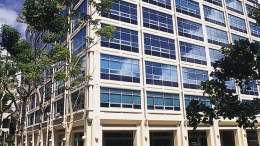Independent Investigation of Lab Accident Complete
The UC team identified the likely physical cause of the March 16 explosion to be an electrostatic charge
Video courtesy of the University of Hawai'i at Manoa
The independent investigation by the University of California (UC) Center for Laboratory Safety into the March 16, 2016 explosion in a University of Hawai'i at Manoa laboratory has been completed. The UC team identified the likely physical cause to be an electrostatic charge and also provided recommendations on how UH and universities and research facilities across the country can improve laboratory safety practices.
- Report 1: Technical Analysis of Accident (PDF)
- Report 2: Recommendations for Improvements in UH Laboratory Safety Programs (PDF)
UH retained the UC Center for Laboratory Safety for the investigation because it is a national leader in developing evidence-based best practices and facilitating implementation and optimization of laboratory safety practices.
 University of Hawai?i at Manoa Pacific Ocean Science and Technology Building.Photo courtesy of the University of Hawai?i at Manoa“The University of Hawai'i thanks the UC team for its thorough investigation,” said UH Manoa vice chancellor for research Michael Bruno. “The lab safety recommendations provide valuable guidance in our commitment to a culture of safety in each and every research and teaching laboratory on our campus.”
University of Hawai?i at Manoa Pacific Ocean Science and Technology Building.Photo courtesy of the University of Hawai?i at Manoa“The University of Hawai'i thanks the UC team for its thorough investigation,” said UH Manoa vice chancellor for research Michael Bruno. “The lab safety recommendations provide valuable guidance in our commitment to a culture of safety in each and every research and teaching laboratory on our campus.”
UH Manoa has already taken multiple steps to improve lab safety including the creation of a Chemical and Physical Hazards Committee made up of representatives from all of the schools and colleges that have research and teaching laboratories. This is one of the key recommendations by the UC Lab Safety Team. The committee will work with other safety-related committees already in existence to identify and implement protocols and processes to further strengthen the safety of UH laboratories.
“Our goal now is to become a national leader in laboratory safety.” said Bruno. “It’s about enhancing our safety culture and standard operating procedures where risks are constantly being identified and minimized. Everybody has a role to play.”
The accident happened in a Hawai'i Natural Energy Institute (HNEI) laboratory and seriously injured a researcher. Following the accident, the university suspended activities at HNEI laboratories working with high-pressure gases, flammable, or explosive materials and other high-pressure work. The labs are still off line and are in the process of completing safety reviews of all activities and equipment.
The university is conducting regular safety peer-reviews among researchers and laboratory staff. The work of each lab group is examined with colleagues from similar and different disciplines, to identify existing best practices and review operations to further ensure safety.
